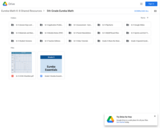
Eureka math
- Subject:
- Mathematics
- Material Type:
- Activity/Lab
- Assessment
- Author:
- Liberty Public Schools
- Date Added:
- 04/07/2021

Eureka math
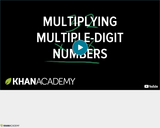
The real world is seldom about whole numbers. If you precisely measure anything, you're likely to get a decimal. If you don't know how to multiply these decimals, then you won't be able to do all the powerful things that multiplication can do in the real world (figure out your commission as a robot possum salesperson, determining how much shag carpet you need for your secret lair, etc.). Common Core Standards: 5.NBT.B.5, 5.NBT.B.7
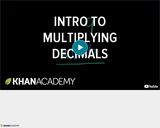
The real world is seldom about whole numbers. If you precisely measure anything, you're likely to get a decimal. If you don't know how to multiply these decimals, then you won't be able to do all the powerful things that multiplication can do in the real world (figure out your commission as a robot possum salesperson, determining how much shag carpet you need for your secret lair, etc.). Common Core Standards: 5.NBT.B.5, 5.NBT.B.7
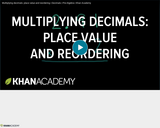
The real world is seldom about whole numbers. If you precisely measure anything, you're likely to get a decimal. If you don't know how to multiply these decimals, then you won't be able to do all the powerful things that multiplication can do in the real world (figure out your commission as a robot possum salesperson, determining how much shag carpet you need for your secret lair, etc.). Common Core Standards: 5.NBT.B.5, 5.NBT.B.7
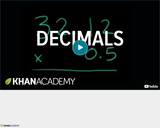
The real world is seldom about whole numbers. If you precisely measure anything, you're likely to get a decimal. If you don't know how to multiply these decimals, then you won't be able to do all the powerful things that multiplication can do in the real world (figure out your commission as a robot possum salesperson, determining how much shag carpet you need for your secret lair, etc.). Common Core Standards: 5.NBT.B.5, 5.NBT.B.7
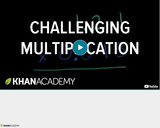
The real world is seldom about whole numbers. If you precisely measure anything, you're likely to get a decimal. If you don't know how to multiply these decimals, then you won't be able to do all the powerful things that multiplication can do in the real world (figure out your commission as a robot possum salesperson, determining how much shag carpet you need for your secret lair, etc.). Common Core Standards: 5.NBT.B.5, 5.NBT.B.7
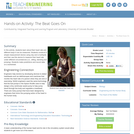
In this activity, students learn about their heart rate and different ways it can be measured. Students construct a simple measurement device using clay and a toothpick, and then use this device to measure their heart rate under different circumstances (i.e., sitting, standing and jumping). Students make predictions and record data on a worksheet.
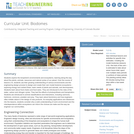
Students explore the biosphere's environments and ecosystems, learning along the way about the plants, animals, resources and natural cycles of our planet. Over the course of lessons 2-6, students use their growing understanding of various environments and the engineering design process to design and create their own model biodome ecosystems - exploring energy and nutrient flows, basic needs of plants and animals, and decomposers. Students learn about food chains and food webs. They are introduced to the roles of the water, carbon and nitrogen cycles. They test the effects of photosynthesis and transpiration. Students are introduced to animal classifications and interactions, including carnivore, herbivore, omnivore, predator and prey. They learn about biomimicry and how engineers often imitate nature in the design of new products. As everyday applications are interwoven into the lessons, students consider why a solid understanding of one's environment and the interdependence within ecosystems can inform the choices we make and the way we engineer our communities.
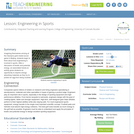
Imagining themselves arriving at the Olympic gold medal soccer game in Beijing, students begin to think about how engineering is involved in sports. After a discussion of kinetic and potential energy, an associated hands-on activity gives students an opportunity to explore energy absorbing materials as they try to protect an egg from being crushed.
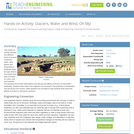
This hands-on activity explores five different forms of erosion (chemical, water, wind, glacier and temperature). Students rotate through stations and model each type of erosion on rocks, soils and minerals. The students record their observations and discuss the effects of erosion on the Earth's landscape. Students learn about how engineers are involved in the protection of landscapes and structures from erosion. Math problems are included to help students think about the effects of erosion in real-world scenarios.

In Module 2 students apply patterns of the base ten system to mental strategies and a sequential study of multiplication via area diagrams and the distributive property leading to fluency with the standard algorithm. Students move from whole numbers to multiplication with decimals, again using place value as a guide to reason and make estimations about products. Multiplication is explored as a method for expressing equivalent measures in both whole number and decimal forms. A similar sequence for division begins concretely with number disks as an introduction to division with multi-digit divisors and leads student to divide multi-digit whole number and decimal dividends by two-digit divisors using a vertical written method. In addition, students evaluate and write expressions, recording their calculations using the associative property and parentheses. Students apply the work of the module to solve multi-step word problems using multi-digit multiplication and division with unknowns representing either the group size or number of groups. An emphasis on the reasonableness of both products and quotients, interpretation of remainders and reasoning about the placement of decimals draws on skills learned throughout the module, including refining knowledge of place value, rounding, and estimation.
Find the rest of the EngageNY Mathematics resources at https://archive.org/details/engageny-mathematics.
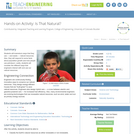
Students will brainstorm ways that they use and waste natural resources. Also, they will respond to some facts about population growth and how people use petroleum. Lastly, students will consider the different ways that engineers interact with and use our natural resources.
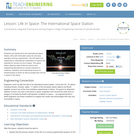
Students are introduced to the International Space Station (ISS) with information about its structure, operation and key experiments. The ISS itself is an experiment in international cooperation to explore the potential for humans to live in space. The space station features state-of-the-art science and engineering laboratories to conduct research in medicine, materials and fundamental science to benefit people on Earth as well as people who will live in space in the future.
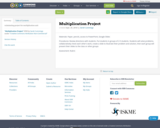
culminating project for multiplication unit
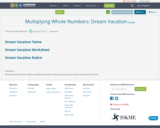
Students practice their skills multiplying whole numbers by planning a dream vacation on Twinery.

(Nota: Esta es una traducción de un recurso educativo abierto creado por el Departamento de Educación del Estado de Nueva York (NYSED) como parte del proyecto "EngageNY" en 2013. Aunque el recurso real fue traducido por personas, la siguiente descripción se tradujo del inglés original usando Google Translate para ayudar a los usuarios potenciales a decidir si se adapta a sus necesidades y puede contener errores gramaticales o lingüísticos. La descripción original en inglés también se proporciona a continuación.)
En el módulo 2, los estudiantes aplican patrones del sistema Base Ten a las estrategias mentales y un estudio secuencial de multiplicación a través de diagramas de área y la propiedad distributiva que conduce a la fluidez con el algoritmo estándar. Los estudiantes se mueven de números enteros a multiplicación con decimales, nuevamente utilizando el valor del lugar como guía para la razón y hacer estimaciones sobre los productos. La multiplicación se explora como un método para expresar medidas equivalentes tanto en el número entero como en las formas decimales. Una secuencia similar para la división comienza concretamente con discos numéricos como una introducción a la división con divisores de múltiples dígitos y lleva al estudiante a dividir los dividendos de número entero y decimales de múltiples dígitos por divisores de dos dígitos utilizando un método escrito vertical. Además, los estudiantes evalúan y escriben expresiones, registrando sus cálculos utilizando la propiedad asociativa y los paréntesis. Los estudiantes aplican el trabajo del módulo para resolver problemas de palabras de varios pasos utilizando multiplicación y división de múltiples dígitos con incógnitas que representan el tamaño del grupo o el número de grupos. El énfasis en la razonabilidad de los productos y los cocientes, la interpretación de los restos y el razonamiento sobre la colocación de decimales se basa en las habilidades aprendidas en todo el módulo, incluido el conocimiento del valor del lugar, el redondeo y la estimación.
Encuentre el resto de los recursos matemáticos de Engageny en https://archive.org/details/engageny-mathematics.
English Description:
In Module 2 students apply patterns of the base ten system to mental strategies and a sequential study of multiplication via area diagrams and the distributive property leading to fluency with the standard algorithm. Students move from whole numbers to multiplication with decimals, again using place value as a guide to reason and make estimations about products. Multiplication is explored as a method for expressing equivalent measures in both whole number and decimal forms. A similar sequence for division begins concretely with number disks as an introduction to division with multi-digit divisors and leads student to divide multi-digit whole number and decimal dividends by two-digit divisors using a vertical written method. In addition, students evaluate and write expressions, recording their calculations using the associative property and parentheses. Students apply the work of the module to solve multi-step word problems using multi-digit multiplication and division with unknowns representing either the group size or number of groups. An emphasis on the reasonableness of both products and quotients, interpretation of remainders and reasoning about the placement of decimals draws on skills learned throughout the module, including refining knowledge of place value, rounding, and estimation.
Find the rest of the EngageNY Mathematics resources at https://archive.org/details/engageny-mathematics.
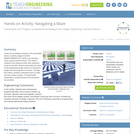
Using new knowledge acquired in the associated lesson, students program LEGO MINDSTORMS(TM) NXT robots to go through a maze using movement blocks. The maze is created on the classroom floor with cardboard boxes as its walls. Student pairs follow the steps of the engineering design process to brainstorm, design and test programs to success. Through this activity, students understand how to create and test a basic program. A PowerPoint® presentation, pre/post quizzes and worksheet are provided.
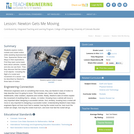
In this lesson, students will explore motion, rockets and rocket motion while assisting Spacewoman Tess, Spaceman Rohan and Maya in their explorations. They will first learn some basic facts about vehicles, rockets and why we use them. Then, the students will discover that the motion of all objects including the flight of a rocket and movement of a canoe is governed by Newton's three laws of motion.
![OREGON MATH STANDARDS (2021): [5.NBT]](https://img.oercommons.org/160x134/oercommons/media/courseware/lesson/image/13138_ODE_Math_Logo_2018-H_color_BvjqVNy.png)
The intent of clarifying statements is to provide additional guidance for educators to communicate the intent of the standard to support the future development of curricular resources and assessments aligned to the 2021 math standards. Clarifying statements can be in the form of succinct sentences or paragraphs that attend to one of four types of clarifications: (1) Student Experiences; (2) Examples; (3) Boundaries; and (4) Connection to Math Practices.
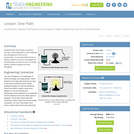
Students learn that charge movement through a circuit depends on the resistance and arrangement of the circuit components. In a hands-on activity, students build and investigate the characteristics of series circuits. In another activity, students design and build a flashlight.